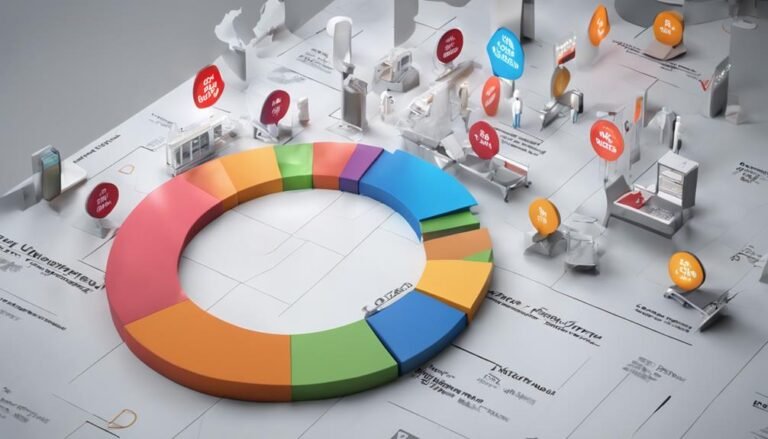Economic Forecasting Techniques
Explore diverse economic forecasting techniques such as time series analysis, regression analysis, neural networks, ARIMA models, econometric models, big data analytics, Monte Carlo simulation, leading indicators, and market surveys. These methods offer a range of data-driven tools to predict trends accurately and make informed decisions. Enhance your forecasting capabilities and strategic planning by utilizing these analytical approaches to gain a competitive edge in understanding economic patterns.
Key Takeaways
- Time Series Analysis: Identify long-term patterns and seasonal trends for accurate predictions.
- Regression Analysis: Collect, clean, and visualize data for precise forecasting.
- Neural Networks: Efficiently identify complex patterns for enhanced forecasting accuracy.
- ARIMA Models: Capture patterns and select reliable models for economic indicator predictions.
- Big Data Analytics: Use machine learning for data-driven decision-making and competitive forecasting.
Time Series Analysis
Time series analysis provides a systematic approach to studying past data patterns to make informed predictions about future economic trends. Trend analysis is an essential component of time series analysis, allowing you to identify long-term patterns and understand the direction in which the data is moving. By delving into historical data, you can uncover valuable insights that help in forecasting accuracy.
Moreover, seasonal patterns play a significant role in economic forecasting. Recognizing these recurring trends enables you to adjust your predictions accordingly, accounting for fluctuations that happen at specific times of the year. Additionally, outlier detection is vital in time series analysis to identify anomalies that could skew your forecasts. By pinpointing these outliers, you can guarantee the accuracy and reliability of your predictions.
Regression Analysis
When conducting regression analysis, you'll focus on data collection methods and the interpretation of results. Understanding how to gather accurate data and how to interpret statistical relationships is essential for forecasting economic trends.
Data Collection Methods
Utilizing regression analysis is a fundamental data collection method essential for extracting meaningful insights from economic forecasting models. To begin, sampling techniques play an important role in regression analysis by ensuring that the data collected is representative of the population being studied.
Data visualization techniques further aid in understanding the relationships between variables, helping to identify patterns and trends that can guide the regression analysis process.
Once the data is collected, the next step involves data cleaning to remove any inconsistencies or errors that could skew the results. This is followed by data aggregation, where individual data points are combined to form a cohesive dataset for regression analysis.
Through these processes, the data becomes more structured and ready for analysis.
Interpretation of Results
Upon completion of the regression analysis, interpreting the results is vital in extracting meaningful insights and understanding the relationships between variables. To effectively interpret the results, consider the following:
- Statistical Significance: Assess the p-values associated with each coefficient to determine if the relationships observed are statistically significant. Low p-values indicate a higher level of significance.
- Confidence Intervals: Examine the confidence intervals around the coefficients to understand the range within which the true population parameter is likely to fall.
- Hypothesis Testing and Model Validation: Conduct hypothesis tests to evaluate the significance of the entire model or specific variables. Additionally, validate the model using techniques like cross-validation to guarantee its robustness and generalizability.
Neural Networks
Neural networks are a powerful tool in economic forecasting due to their ability to identify complex patterns in data that mightn't be apparent through traditional methods. They can handle large amounts of data efficiently and are capable of adapting to changing environments, making them versatile for various forecasting tasks.
Understanding the basics of neural networks and their applications in forecasting is essential for harnessing their predictive capabilities effectively.
Neural Network Basics
Understanding the fundamental principles of neural networks is essential for grasping their significance in economic forecasting techniques. Neural networks, a key component of deep learning and artificial intelligence, are designed to mimic the human brain's ability to process and analyze complex patterns. Here are three key aspects worth noting:
- Parallel Processing: Neural networks excel in parallel processing, allowing them to handle multiple tasks simultaneously. This feature enhances efficiency and speed in analyzing vast amounts of economic data.
- Non-linearity: Neural networks can capture non-linear relationships within data, providing a more nuanced understanding of complex economic variables. This ability to model intricate interactions contributes to their effectiveness in forecasting.
- Adaptability: One of the strengths of neural networks is their adaptability. They can learn from new data inputs, update their internal parameters, and improve their forecasting accuracy over time. This adaptability makes them valuable tools for economic forecasting in dynamic and evolving environments.
Applications in Forecasting
Analyzing economic trends with neural networks can provide valuable insights for forecasting future market conditions. Neural networks excel in capturing complex relationships within data, making them a powerful tool for economic forecasting. By processing vast amounts of information simultaneously, neural networks can detect subtle patterns in economic trends that traditional models may overlook.
When it comes to forecast accuracy, neural networks have shown promising results in predicting economic indicators like GDP growth, inflation rates, and stock market performance. Their ability to adapt to changing market dynamics and learn from historical data enhances the precision of forecasts. Neural networks can handle non-linear relationships and noisy data more effectively, enabling forecasters to make more informed decisions.
Incorporating neural networks into economic forecasting processes can lead to more accurate predictions and better risk management strategies. As technology continues to advance, leveraging neural networks for analyzing economic trends will likely become increasingly essential for organizations seeking a competitive edge in forecasting market conditions.
ARIMA Models
Utilizing ARIMA models enhances the accuracy of economic forecasting by incorporating time series data analysis techniques. ARIMA, which stands for Autoregressive Integrated Moving Average, is a powerful tool for analyzing and predicting time series data.
Here are three key points to take into account when using ARIMA models for economic forecasting:
- Forecast Accuracy: ARIMA models are adept at capturing patterns and trends within time series data, allowing for more accurate predictions of future economic indicators.
- Model Selection: Choosing the appropriate ARIMA model involves selecting the orders of differencing, autoregression, and moving average components based on the characteristics of the data. This careful selection process is essential for achieving reliable forecasts.
- Data Analysis Techniques: ARIMA models rely on analyzing historical data to identify patterns that can be used to make informed predictions about future economic trends. By incorporating these techniques, ARIMA models can provide valuable insights for decision-making processes.
Econometric Models
To further enhance the precision of economic forecasting beyond ARIMA models, exploring Econometric Models provides a robust framework for analyzing relationships among economic variables. Econometric Models are valuable tools for understanding causal relationships and improving forecast accuracy. Model selection and variable selection are vital components in econometric modeling to guarantee the accuracy and reliability of forecasts. By incorporating various economic variables into the model, researchers can capture the complex interplay among different factors influencing the economy.
| Econometric Models | Description |
|---|---|
| Causal relationships | Explore cause-and-effect connections in data |
| Forecast accuracy | Measure the precision of future predictions |
| Model selection | Choose the appropriate model for analysis |
| Variable selection | Identify relevant variables impacting the model |
Careful consideration of these key aspects in econometric modeling is essential to produce reliable forecasts and gain insights into the dynamics of economic systems.
Big Data Analytics
Big Data Analytics plays a pivotal role in extracting valuable insights from vast and varied datasets to inform decision-making processes in diverse industries. Leveraging machine learning algorithms, organizations can analyze large volumes of data at high speeds, uncovering patterns and trends that would be impossible to identify through traditional methods. Predictive modeling, another key aspect of Big Data Analytics, allows businesses to forecast future trends based on historical data, enabling them to make informed strategic decisions. Through the integration of these advanced analytical techniques, companies can enhance their forecasting accuracy and gain a competitive edge in the market.
Machine learning algorithms enable automated data analysis and pattern recognition.
Predictive modeling helps anticipate future trends and outcomes based on historical data.
Big Data Analytics empowers organizations to make data-driven decisions, improving operational efficiency and strategic planning.
Monte Carlo Simulation
Monte Carlo Simulation is a powerful technique used in economic forecasting to simulate a wide range of possible outcomes based on probabilistic inputs. By incorporating probability distributions and random variables, this method enables analysts to model the uncertainty and variability present in economic systems. Through repeated random sampling, Monte Carlo Simulation generates a plethora of scenarios, providing a thorough view of potential future states.
In economic forecasting, Monte Carlo Simulation plays an essential role in risk assessment and decision-making processes. By running simulations based on different input parameters, analysts can assess the likelihood of various outcomes and identify key risk factors that may impact the forecasts. This allows decision-makers to make informed choices by considering a spectrum of possibilities rather than relying on single-point estimates.
Leading Indicators
Leading Indicators provide valuable insights into the future direction of an economy by signaling potential changes before they occur. These indicators are essential for policymakers, businesses, and investors to anticipate economic trends and business cycles accurately. By analyzing leading indicators, you can make informed decisions to mitigate risks and capitalize on opportunities in a timely manner.
- Leading indicators help in predicting shifts in economic trends, such as changes in consumer spending patterns or investment behaviors.
- These indicators offer early signals of upcoming fluctuations in business cycles, enabling proactive adjustments to strategies and operations.
- Utilizing leading indicators allows for a proactive approach to managing risks associated with economic uncertainties and market volatility.
Market Surveys
Market Surveys provide essential insights into consumer preferences and behavior, guiding strategic decision-making for businesses and policymakers alike. By conducting thorough market research, organizations can gather valuable data on consumer sentiment, purchasing patterns, and future trends. These surveys serve as an important tool in understanding the ever-evolving market dynamics and staying ahead of the competition.
Analyzing consumer sentiment through market surveys enables businesses to adapt their products and services to meet changing demands effectively. By collecting data directly from consumers, companies can identify emerging trends, preferences, and concerns, allowing for proactive decision-making and targeted marketing strategies.
Moreover, market surveys play a significant role in evaluating customer satisfaction, brand perception, and loyalty. This feedback loop is invaluable for companies looking to improve their offerings and enhance customer relationships. Policymakers also rely on market surveys to gauge public opinion on economic policies and social issues, aiding in informed decision-making for the benefit of society as a whole.
Conclusion
To sum up, economic forecasting techniques serve as the compass guiding decision-making in a turbulent financial landscape. Like a skilled navigator relying on a combination of tools and insights to steer through unpredictable waters, these methods offer valuable insights into future trends.
By utilizing a variety of analytical tools such as time series analysis, regression analysis, and neural networks, businesses can better navigate the turbulent seas of the market with confidence and precision.








